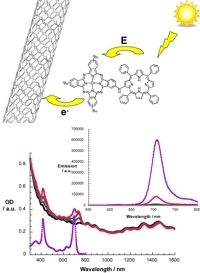Low dimensional carbon allotropes as light harvester and reaction centers
Carbon is the key to many technological applications from drugs to synthetic materials that have become indispensable in our daily life and have influenced the world's civilization for centuries. Altering the periodic binding motifs in networks of sp3-, sp2-, and sp-hybridized C-atoms represents the conceptual starting point for constructing a wide palette of carbon allotropes. To this end, the past two decades have served as a test-bed for measuring the physico-chemical properties of nanocarbons in reduced dimensions starting with the advent of fullerenes (0D), followed in chronological order by carbon nanotubes (1D) and, most recently, by graphene (2D). These nanocarbons are now poised for solving a far-reaching challenge, that is, the efficient use of the abundant light energy around us.
From that perspective, light harvesting through advanced photon management, which enables efficient absorption within very thin film, is very desirable, since it will minimize optical and transport losses to improve the efficiency. A particularly promising approach to advanced photon management relies on the large specific surface area of, for example, nanocarbons. Single wall carbon nanotubes and graphene represent novel and ideal architectures because they allow broader spectral absorptions through increased chromophore loadings, thus relaxing design requirements for the sensitizing components. I will present our design principles to decorate nanocarbons with molecular, particulate, and polymeric chromophores that feature optimized light harvesting, facilitate unidirectional charge transfer, and enable efficient charge transport.
Our experimental approach is based on femto-, pico- and nanosecond-resolved photolysis experiments - with fluorescence and transient absorption detection and with tunable excitation wavelengths. These are at the forefront of our investigations to characterize dynamic processes that are associated with the generation and fate of photoexcited states including Förster resonant energy transfer, charge separation, charge injection, charge recombination, charge transport, etc.


